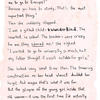4: Visual essay excerpt, Rutu Modan’s “Chez Maurice,” 2007.
Many of Rutu Modan’s works explore intergenerational relationships, an important central theme in The Property. Mica and her grandmother, Regina, seem to have a generally loving relationship. They have chosen to travel together on this important trip. But at times there are tensions between them and, after all, the story centers around a secret that Regina has kept from her family, in order (from her point of view) to protect them. Mica, too, occasionally does things behind her grandmother’s back, acts that can be interpreted as well-intentioned, but not necessarily honest.
This excerpt is from the final section of a 2007 memoir piece that Modan composed for the online New York Times Blog. Called “Chez Maurice,” this visual essay is made up of seven long, rectangular panels, each enclosed within a watercolor background. Some of the panels, like this one, contain no drawings and contribute to the story entirely with handwritten prose. Others include tiny drawings of scenes from the story, for example, an illustration of the protagonist driving a car, her grandmother seated beside her.
“Chez Maurice” is the story of a day when the twenty-year-old protagonist is asked to take her grandmother (her father’s mother) to the hairdresser. In the first half of the story, we learn that the granddaughter doesn’t particularly like her grandmother because of the grandmother’s scornful attitude towards the granddaughter’s working mother. The granddaughter is also sore that her grandmother has expressed disapproval about a backpacking trip around Europe she has been looking forward to.
In this penultimate panel, the narrator gets a glimpse of “the young girl inside that old woman,” as her grandmother mentions that her own father did not allow her to go to university because he “thought it wasn’t suitable for girls.”
Suggested Activities: Present the class with this excerpt from the comic. Ask students to think about the form as well as the content of the piece. Why do they think the author—a cartoonist—decided to create a story that includes long pieces of handwritten prose, like this one, instead of either typeset prose or comics (words and images together)? What effect does seeing the author’s handwriting have on their perception of this snippet?
Have them also reflect on the intergenerational relationship depicted here. What might the narrator mean when she says, “She looked very small to me then.” What kind of realization was the narrator having about her grandmother in this moment? Do they think this interaction will change the way the two of them relate to each other in the future? Why or why not? How does the relationship between the granddaughter and her grandmother compare to what we see in The Property? In what ways are these pairs similar, and in what ways are they different? Do you think Modan is trying to send a different message about intergenerational relationships in The Property than in “Chez Maurice”?
Students can then individually reflect on a relationship they have had with a person of a different generation—this could be a grandparent, or any older relative, caretaker, or teacher. Have they ever had a revelatory moment with that person, like the one the granddaughter has in “Chez Maurice”? How did their perspective on this older person shift? Students can write about this relationship and an important moment in it for 10-15 minutes.
Optionally, students can then adapt this short reflection into a story that incorporates images and words. This could be a conventional comic, or it could be a collage, or a mix of handwriting and illustrations, like “Chez Maurice."
Source: Rutu Modan, “Chez Maurice,” Mixed Emotions (blog), The New York Times, Oct. 3 2007, https://modan.blogs.nytimes.com/2007/10/03/chez-maurice/?module=BlogPost-Title&version=Blog%20Main&contentCollection=Opinion&action=Click&pgtype=Blogs®ion=Body.
Chez_Maurice_excerpt.jpg
 Download image (397.01 KB)
Download image (397.01 KB)

